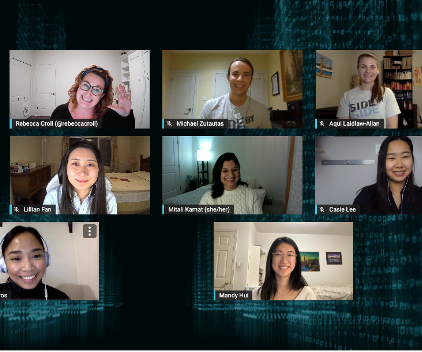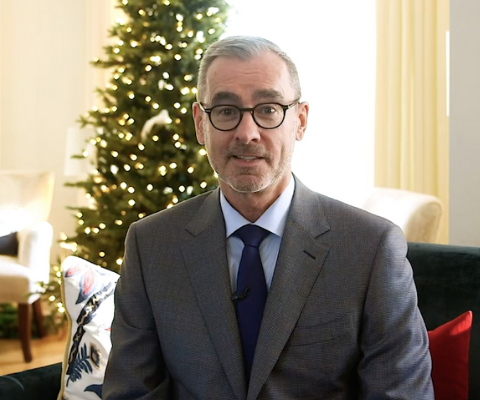Convergences 2016 : L’avenir des nouvelles technologies de l’énergie
Text on screen: [Mindshare logo, Inspired thinking on the future of energy]
Text on screen: [New Energy Technologies and Innovation, Europe]
Text on screen: [Andreea Strachinescu, Head of unit, New Energy and Technologies and Innovation, Directorate General for Energy, European Commission]
Andreea Strachinescu: So good morning, everybody. I’m very pleased to be here today. Thank you for the invitation. And I hope at the end of the day, based on our exchanges, we’ll find a way to advance. I saw that the other speakers are coming from all around the world, and I’ll like to explain a little bit what we are doing in Europe and how we see the future. And you see that we are speaking first about an integrated European Union energy system. It’s not an energy system, but an energy system in which we address – we try to address – all the synergies, and to see how we can make it function in an integrated way properly. There are challenges, but there are also opportunities.
So I will present, as I said, what are the challenges, what is the main policy which came up last year, especially energy union, and what we are doing in the field of energy technologies and innovation. Challenges. In fact, the challenges in Europe, probably they are starting a little bit from the – how the energy system is built, and the fact that in most of the parts of the world we are still – we have still a strong dependence on fossil fuels. And fossil fuels which, in comparison probably with Canada, they are not coming from Europe. Most of them are imported. So based on this, of course that the policy at a certain point starting addressing this import dependency and look how this can be replaced. And all the developments started around in 2007, when the first policy in this field was announced. If we are looking a little bit, we saw that production and use of renewable energy – renewable energy increases, but still the percentage is very low. We have renewable energy coming from hydro, but the challenges – big challenges are around the variable renewable energy production and its proper integration into the energy system.
Challenges are also coming from the fact that we are speaking about an union which is formed from 28 member states. European Union is not a federation. There are common policy, there are sectors for which the countries gave to European Union the right to act on their behalf, but energy is not one of these. So 28 countries, 28 different environments, 28 different dependence on resources. And also, I may say 28 different also historical relations among themselves, and also traditional corridors, if I can say, of import of energy. We are speaking about liberalization of the market, but of course the reality is different if we are looking at all 28 member states. We still need and there is a lack, I may say, of energy corridors among the European Union countries. Of course that if we want an integrated market for energy, we need the energy flows to be able to circulate properly among the European Union countries. We are working on this, but currently, just to give an example, the interconnection – the interconnection degree for electricity of the level of European Union is to be ten percent quite let’s say in the future. So looking at this, you see that currently we cannot see at about – we cannot speak about an integrated energy market. But it’s there that we like to go.
Now, of course that in terms of dependency, as I mentioned, you may see that European Union, it’s among the part of the world which has the strong dependence on import – import of energy sources, which has an increasing trend over the 15 years, I may say. And this trend is continue to continue. It’s said to be there. Because according to the estimation of International Energy Egypt, European Union with Japan, are the ones for which the increase in dependency in imports is to be the most important in the next period of time. We see that there are countries – of United States, probably it’s the one which succeeded to solve this problem of dependency on imports. And looking a little bit of developments, of course that we cannot change everything in terms of imports in the next period of time with renewables. This may takes time, and we need to proper address this.
Based on this, gas is continue to be in the energy system of the future. And if we are looking at what there are LNG terminals currently planned in Europe, we see that there is a willingness to increase the number of these. Why gas? Of course that in terms of objectives for the carbonization, gas is among the fossil fuels which has the lowest impact, if we can mention this. I will – I’ll come back a little bit on this. Because looking at all the countries and the objectives that there are for the carbonization linked to the development of renewables, you may see that the realities are different in Europe. There are countries which the – for which the degree of share of renewable energy in the final use of – in the final energy consumption, it’s high. I mean, for the Nordic countries, there we do not have a lot of viable energy. There is hydro, which is mostly, but for all the other rest, there is the variable renewable energy production that is going to be developed. When you have variable energy production, you have big challenges in terms of flexibility. Becau—also the variability in the production has to replace by a stable production of energy in order the system to be able to function properly. And increasing flexibility of the level of the system, it’s a big challenge at the level of the European Union.
In terms of options, all possibilities are to be considered. And of course that, as I mentioned previously, we need better interconnections among the member states. We need also to consider new technologies. We need to consider storage. We need also to consider demand response, but also flexible production. Flexible production and, as I mentioned previously, of course that gas is the one which has the lowest impact on the environment. And not at the le—not at the end, looking at the final use of energy, we can see that it’s not electricity, the one which causing the big problem, but it’s heating. Heating and cooling represent half of the final use of energy in Europe. So at the beginning of this year, European Union came with a strategy on heating and cooling because things are to be changed here, an increased use of renewables to be done in this sector, of course transport as well.
So in terms of energy policies which are domes—which are the main objectives, first of all, it’s security of the energy supply, but also the energy prices. You are probably aware that energy prices are – for the consumers, there are quite – they are quite high in Europe, and energy prices are important not only for the consumers, but they are important also for the industry, in order to maintain the competitiveness of the European industry. Protecting the environment, and of course linked to this, all the carbonization objectives, of course linked also in – with the climate change objectives, and following all the developments which were established in Paris at the end of last year. And, not at the end, the energy infrastructure and energy grids, because Europe needs new technologies at the level of the grids in order to increase the integration of renewables, but also the fact that energy grids are coming at a certain age and we need to – we need to foreseen their replacement in some places.
So, based on this, what are, I may say, the main objectives? As previously mentioned, you see that there is a triangle looking at the security of supply, sustainability, and competitiveness. I may not say that competitiveness is at the top and the security supply are the base. So all of them are important, and the triangle may rotate, and in some moments you may have one of them, let’s say, being at the top of the policy. But all of them are extremely important. So based o this, what I previously mentioned, development of renewable sources of energy, diversification of supply and security of supply, energy efficiency, which is one of the top policy in Europe, but also smart infrastructure, new energy grids, and development of competitive markets in Europe for energy.
Based on this, in 2007 there were established the energy policy targets, which probably you are aware. And we are speaking about reducing greenhouse gas emissions by 20 percent in comparison with 1990. We increase – we speak about increased share of renewable energy in the final use of energy by 20 percent, and increased energy efficiency by 20 percent. Probably this will be how it will look in 2020. So the ones, the targets for renewables and for greenhouse gases reduction will be achieved. But energy efficiency, still efforts are to be done. Energy efficiency probably is the sector where it’s most difficult because we are speaking a lot about involvement of the consumer, involvement of the public consumer, and we are speaking about investments which are needed to be done at the level of households. We are speaking also about change in behaviour. It’s probably one of the most difficult things to be done, change in behaviour. And when addressing the energy policy, we are looking also at this part of innovation.
Then, in 2014, the European Union – of course because 2020 is just tomorrow, if I may say, we need to establish a trend. We need to see what we are going in the future. We established the objectives for 2030. And now the level of obition (ph) for the greenhouse gas emission will be doubled in comparison in 2020, and we are speaking about – we are speaking at least 20 percent renewable energy at the European Union level and energy efficiency improvement but at least 2000 – 2000 – 27 percent. So we are speaking about a reformed emission trading scheme, but also new indicators and a better governance system among the member states because the targets for the renewable energy and for the energy efficiency in 2030, in comparison in 2020, they will not be binding at the level of the member states. We are speaking about the targets at the level of European Union, which increase the challenge and put a lot on – in discussion the collaboration among the member states.
There is also the energy security strategy, which builds on what I mentioned previously. It was elaborated mostly when it was the crisis (ph) is Ukraine, it was winter, and the decision was taken to see what is going to be done if the crisis will come up. So how we are going to address this? Of course that we need to complete (ph) the internal market. The consumers, as I mentioned, they have to be placed at the centre. Energy efficiency are key. We have to improve the investments, and we need a behaviour change. We have of course to decrease the cost of renewable technologies, but also we need to proper integrate these renewable technologies in the energy system.
Infrastructure is key also in development, and development of energy supplies and diversification. So at the beginning of last year, Energy Union came. It’s a strategy which was developed, and it’s looked, as I mentioned, in order to – it looks in order how all of this has be—has – can be achieved, and the collaboration among member states to be improved. It has five guiding dimensions. For each of the dimensions there are actions which are foreseen, and also initiatives. So the first pillar, it’s security of supply. You may see that there are, let’s say, probably things which were previously mentioned. The secondly, it’s the fully integrated energy market, and the fact that we need better regional cooperation among the member states, and to improve the flow of energy among the countries. Energy efficiency. Energy efficiency, key element in the energy policy, especially looking at the building sector because buildings are responsible for most of the energy consumption at the level of European Union. So a lot is to be done in terms of renovation of buildings and changing all the norms in terms of new buildings in Europe.
Fourth pillar, the carbonization. Here we are speaking about renewables. We are speaking about the ambition at the level of the Commission of being number one in reimbursing to the world. That means developing cost-efficient technologies, performant technologies, but also proper integrate into the energy system the energy which is then generated. And the fifth, research, innovation, and competitiveness, which was acknowledge—
Text on screen: [Mindshare logo, Inspired thinking on the future of energy]
Andreea Strachinescu, chef de l’unité Nouvelles technologies de l’énergie et innovation à la Direction générale de l’énergie de la Commission européenne, parle des Nouvelles technologies de l’énergie et innovation en Europe.
Vidéo et transcription disponibles en anglais seulement
Catégorie : Recherche et innovation




